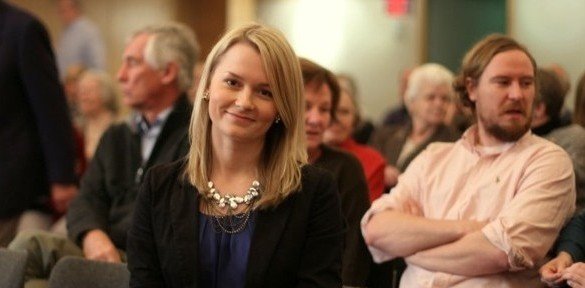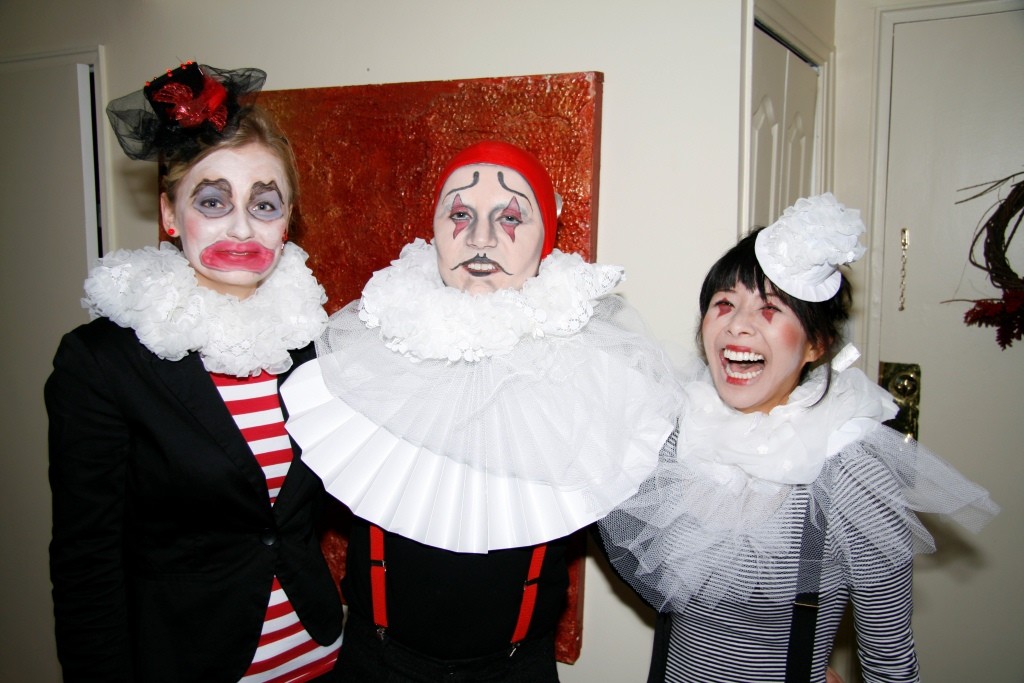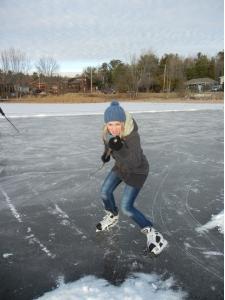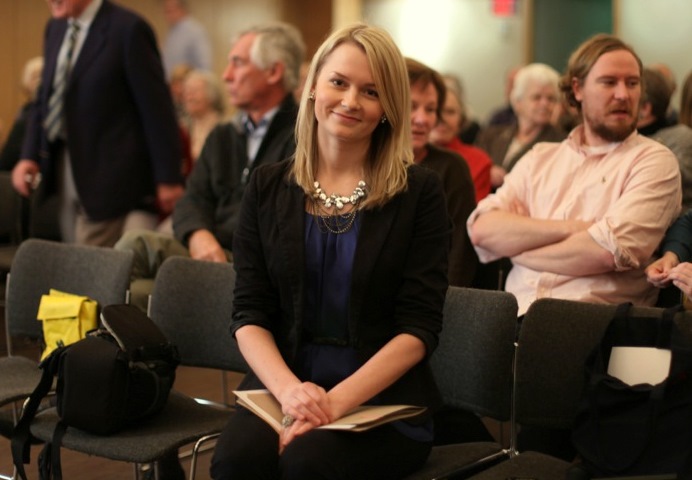Reelika Virunurm explores the story behind “Kati and me” – how an Estonian girl called “Kati” prompted a Canadian couple to visit Estonia, fall in love with the country, and make a short film about it – the film which has become an internet sensation in last few weeks.
It all started with Estonian World sharing the short film “Kati and me” – surprisingly the only film ever submitted to the Estonian film festival “EstDocs” in Toronto by two people of non-Estonian heritage. From EW it was picked up by Edward Lucas, who is known for his affinity towards Estonia, with president Toomas Hendrik Ilves and the Estonian, Canadian and Baltic media following. The film clip has already been viewed more than 50,000 times on YouTube. As one of Kati´s Canadian friends wrote to her after the tweet from the president: “Are there only like 30 people living in Estonia, or how does that happen? Seems suspicious…”
The Canadian couple Mike Dell and Kimberly Bagayawa, authors of the humorous short film, put together most of it just within five days. The idea had taken root when Kati was about to leave Canada, so they were determined to visit the country themselves. Since the video has gone viral, a lot of people have also been contacting them asking how Kati is doing and whether they are still friends. Since I´m lucky enough to know all the accomplices personally, I decided to tell their story. What lies behind this tale of Estonian-Canadian friendship? Who is Kati and what did she do to make her Canadian flatmates not only to fly thousands of kilometres to visit Estonia (and granny´s farmhouse), but also to make a film about their experience?
“We were like peas in a pod… or raisins in a loaf of kringel”
Like many adventures, this one started at the airport. We picked Kati up, and we admit to having been nervous as we wanted her to feel comfortable in Toronto, and in our apartment, being so far away from home. We had already exchanged a lot of e-mails, and she seemed very easy-going and friendly.
Mike: Kati still claims she gave us a hug right away at the airport, but I remember it was a handshake!
Kim: It did become comfortable with her living here in a very short time. Her first Friday night in Toronto she joined us for a dinner party with friends, which turned into an all-weekend spontaneous trip to Niagara Falls! The first weekend was already crazy, we even went gambling there, it was her first time ever in a casino. I guess it was kind of an initiation ritual and she passed. That´s when we realised that she´s not shy at all, and that if she can do this spontaneous stuff with us, she must be pretty open-minded.
Mike: And luckily she didn´t get addicted to gambling…
“Over morning coffee, we´d learn all about granny, the farmhouse, long summer days in June and Estonian history”
At first it was just like we said in the film – fun and relaxed conversations over morning coffee. (And evening wine). In Canada there are so many different nationalities living together, but we didn´t know anything about Estonia really, so we asked Kati a lot of questions. And we heard about granny a lot!
We watched the film about the Singing Revolution together, which gave us a very good overview on the hardships Estonia went through, and the love of Estonians for their country. “Suvi” was a bit lighter to watch after that, but Mike did fell asleep.
Mike: Around Christmas, Kati tried to make mulled wine at home, but kept telling us “this is not quite what it´s supposed to taste like”. Then we went to the local Swedish Christmas market, ate a lot of gingerbread cookies and savoured the mulled wine there.
When and how did you get the idea for the film?
Mike and Kim: Just a few days before Kati was leaving at the end of February, we went to the opening of the exhibition she had helped to organise, called “Am I Estonian?” After the opening, everybody had delicious kringel and coffee, and flyers about the EstDocs Festival were being passed around. We asked if we can also make a film even if were not Estonians, and they said the festival is open for everyone.
Kim: Afterwards we realised that we should have taken more videos when she was here. But it was not until July that we decided to take the trip to Estonia.
Mike: After visiting Estonia (and also Hannover where Kati is currently living), we had very little time to put it all together. We were discussing it on the flight home, and decided the movie had to be on Estonian spirit. We came up with everything on the plane actually! We put together the videos and the photos, and I added the music. It was pretty much done in five days, and we submitted it only a few hours before the deadline.
Kim: When I went to deliver the DVD, the lady receiving it cast me a very funny look at first, like I was lost. Apparently we were the first non-Estonians to submit a video to this festival.
“In order to really grasp the spirit of Estonia… we needed to see Estonia for ourselves”
Kim: I remember driving to Kati´s house, it was late at night, with all the winding roads and the dark forest all around. I had a very surreal feeling when we finally arrived. We had only seen granny´s house on Google maps, and after actually seeing it for real, I couldn´t believe that we had really travelled all this way!
Mike: We wanted to meet Kati´s family most of all of course. There was a huge supper waiting for us and everybody was so nice and hospitable. And we had heard so much about everyone, so it felt like we knew them right away. It felt really special.
“We drove for miles and miles into the Estonian countryside, stopping at manors, castles and taverns along the way”
Mike: We saw a lot in five days, but most of all just tried to grasp the spirit of the people. And I guess everyone is saying that Tallinn´s Old Town is amazing?
I know what I found to be really special – all the manors and castles we went to, always had a piano. In Canada we have pianos all over the place as well, but always locked up, forbidden to touch. There they even kindly asked me to play everywhere we went to! It was like living history, one of the pianos was quite ancient and had belonged to a famous Russian composer. They would never let you lay a finger on it in Canada, they would have armed guards and snipers on the roof guarding it.
“No wait, that´s Madonna. She´s not Estonian”
Kim: And then there was the night in Püssirohukelder in Tartu…
Mike: Well, I learned some important things there. I ordered a half-liter beer, looked around and realised that only women were drinking half-liter beers! All the men had one-liter beer mugs. So I had to blend in. After that, everything got kind of fuzzy really fast… But the karaoke part was great though.
“It´s the feeling that seems to hold everything together, the spirit. Its what bridges the new and the old, the city and the rolling countryside, the medieval and modern, singing to Skype, granny to granddaughter…”
Kim: There was one very magical night called Muinastulede öö (night of the ancient bonfires). We were told that it is a tradition in the Nordic countries to light bonfires on the last weekend of August on the seaside. Kati took us to Viimsi, one of the seaside parts of Tallinn, we had dinner at the restaurant “Paat”, and afterwards everyone went to the sea and lighted up some small lanterns and released them all together into the night sky. It was very magical. This proved us again how the Estonians still value their old traditions, and mix them with all the cool innovative stuff they have come up with.
Mike: A strange coincidence also occurred. On our last day in Tallinn we were walking in Kadriorg and noticed two girls shooting a dance video. Back home, we got a message on YouTube from someone who had enjoyed the film. When we checked her channel, she was the author of the same dance video they had shot in Kadriorg! Now I believe everybody knows everyone somehow in Estonia!
Afterwards, I´m meeting Kati – or Katre Viilvere, as she is otherwise known – the star of the film, at a cafe in Hannover, Germany, where we both currently live. We have been very good friends for over three years. As two Estonians living abroad, not only did we offer mutual support to each other during our master studies at the Hannover University, we also share the pain of missing black bread and sour cream; and have watched together the whole series of “Tuulepealne Maa”.
Although being blond and speaking German without an accent often results in Kati being mistaken to be a German, she is in fact very proud to be Estonian. So when she had to choose topic for her master thesis, she decided to associate it with her semester abroad and do research on the young Canadian-born Estonians living in Toronto, one of the largest Estonian communities outside of Estonia.
Kati, why did you decide to go to Canada in the first place?
I was really hoping to do my internship somewhere Estonian-related and maybe even use it for my thesis later on. At first I contacted some Estonian embassies abroad, and the Embassy of Ottawa sent me the contacts of Piret Noorhani, coordinator at the VEMU Estonian Studies Centre in Toronto. I did not have a specific topic for my research at first, but arriving in Canada and talking to the Estonians there helped to get things rolling.
Mike and Kim made me feel at home right away – it is amazing how fast some people can become your good friends. After having lived there for a month, we all felt like it has been a year at least.
What is your secret – how did you get Mike and Kim so interested in our small country and its culture?
I have been living abroad for some time and always telling people more about Estonia comes naturally to me. It´s harder coming from a small country I guess. But Kim and Mike were also very open-minded and curious. I showed them a lot of photos and played Estonian music. We also went to eat at the cafe at the Estonian House. I think we had some cabbage rolls, stroganov and stritsel. Mike wasn´t convinced he should try the blood sausage though…
Arriving in Canada
Coincidentally, almost the first thing I did after arriving in Toronto in October 2011 was going to the EstDocs festival. There were so many Estonians, I ate a lot of kringel and heard everyone speaking Estonian. Seemed surreal at first, being so far away from home. Later I noticed there really was kringel at every Estonian event I went to!
The Canadian Estonian community there is very active, it amazed me how many opportunities they have to be socially active – Estonian School, many organizations, choirs, summer camps for the children. I was gradually introduced to all of it after starting my internship at VEMU Estonian Studies Centre and interviewing Estonians of different generations for my research.
Meeting Canadian-born Estonians
Meeting a lot of people from the first generation of Estonians who had emigrated to Canada during or after the World War II was very special. Although they had been living there for over half a century, most of them spoke Estonian without an accent! It felt like home, talking to them, they were very sweet and not at all different from my own grandparents in Estonia.
Until now, the Estonian community has been very strong thanks to the older generation who have kind of built and maintained it, but things are about to change. The third generation is also taking a strong interest in being Estonian, and keeping their Estonian heritage alive.The young Canadian-born Estonians realise that it is their responsibility after their parents and grandparents. They are prepared to fight for it.
During my interviews, most of the young Estonians who are born in Canada, acknowledged that one of the modern “dangers” is that they have very many interests due to growing up in a multicultural society, and also due to globalisation. This is kind of the downside to globalisation – having too many opportunities and trying to conform them with your heritage. They have so many opportunities that it is getting harder to also find time to concentrate on just one thing. Most of the young Canadian-born are also learning and using Estonian, but English is still dominant and the daily language.
Still, there is also a positive side to globalisation – it is much easier for Canadian-born Estonians to maintain contact with Estonia, and their friends and relatives there (especially compared to the Soviet times). Travelling is easier and many young people own a double citizenship, allowing them to go study or work in Estonia, and Europe in general. The social media – Skype, Facebook – also play a great role, their grandparents had very few means of keeping in touch with Estonia.
Third-generation Estonians and their secret language
It did surprise me a little that the young people of the third generation still strongly believe in maintaining a strong Estonian community in Canada. The Estonian language is very important to them – it is something special, like a secret language among themselves! The summer camps Jõekääru, Seedrioru and Kotkajärve carry a very special meaning as well. Talking Estonian is not a must there though, everyone has an equal opportunity to take part and form friendships. They value their friendship with other Estonians, as something more special than with other Canadians.
The younger generation would like to have more diverse events to preserve the interest and the feeling of being Estonian – besides old traditions like singing in a choir and folk dance, they wish for more modern events. Some of the ideas offered were an Estonian theatre group, or even a special youth house for spending time together, as not everyone attends the Estonian School.
“Am I Estonian?” exhibition
My wonderful coordinator in VEMU, Piret Noorhani, came up with the idea to organise an exhibition based on my research on the Estonian third generation in Canada. We started putting it together in December last year and the opening was in February, on my last night in Canada. I also received a lot of help from Kirsten Dobbin and Kerly Ilves. We put together photos, quotes from the interviews, and a lot of personal objects, symbolising what being Estonian meant for them – books, dolls, flags, beermugs and handcrafts. On the opening night we had over 100 visitors and a two-hour culture program. The exhibition itself was sent further to Tartu Kirjandusmuuseum.
Let´s end this with a cliché – and what does it mean for you to be Estonian?
Speaking our unique language and celebrating all the special traditions. I am grateful for the opportunities I have had – to go to university abroad, live in different countries and travel a lot. I´m not quite sure about my future plans right now, but I will most definitely always be Estonian. Living abroad has taught me to appreciate and notice everything special about Estonia – let it be either granny´s farmhouse or Estonian pure nature and countryside.







Thank you, Reelika! It’s brilliant!!
This was a wonderful article. As a member of that Third-Generation Estonian group, I would say your analysis is spot on! 🙂
Really interesting to hear the story behind the short film. Great article.
Great article! Many thanks from this 2nd generation Estonian.!
Many thanks! Lovely article to share with my second generation child in the US.